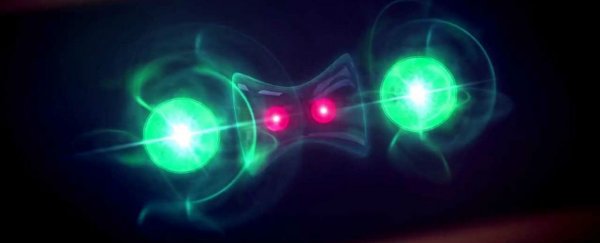For the first time, scientists have subjected quantum entanglement to extreme levels of acceleration, and there's nothing fragile about this "spooky action at a distance"- it's way more robust than we thought.
In recent experiments, entangled particles held firm even while being accelerated to 30g - 30 times Earth's acceleration - and the results could have a big impact on our search for a unified theory of modern physics.
"These experiments shall help [us] unify the theories of quantum mechanics and relativity," says one of the team, Rupert Ursin, from the University of Vienna, Austria.
Quantum entanglement is one of the most frequently tested manifestations of quantum mechanics, but there's still a lot we don't know about this bizarre phenomenon, where two particles essentially 'share' an existence.
This means what happens to one particle will directly and instantly affect the other - even if that other particle is many light-years away.
We know from countless experiments that entanglement is real, but that's something Einstein's relativity cannot explain. So now modern physics is stuck between two incongruous realities that no one knows how to unify.
A big part of figuring out how to bridge the gap between quantum and classical physics is being able to observe aspects of both simultaneously, and Ursin and his team have done just that, by subjecting entangled particles to high accelerations described by relativity.
To do so, the researchers mounted a source of entangled photon (light particle) pairs in a crate, which they first dropped from a height of 12 metres to achieve zero gravity during a free-fall.
Next, the crate was attached to the arm of a spinning centrifuge and then accelerated up to 30g. To put this into perspective, a roller coaster will subject you to just 6g, and at around 9g, most humans black out, as blood struggles to reach the brain.
Detectors mounted to the crate were there to monitor the photons' entanglement as they underwent these major stress tests, and revealed that the 'spooky' pairing had held firm within the milli-g (drop tower) and hyper-g (centrifuge) conditions.
"Our results show that quantum entanglement is unaffected by non-inertial motion to within the resolution of our test-system," the researchers conclude.
"This represents the first experimental effort exposing a genuine quantum system to milli-g and hyper-g, and extends the experimental regime in which quantum effects can be said to exist in harmony with relativity."
Not only is this a big win for physicists wanting to observe the effects of quantum and classical physics simultaneously - the fact that the photons remained firmly entangled through such extreme testing means we don't have to be worried about them breaking apart in experiments beyond an Earth-bound lab.
"If entanglement were too fragile, quantum experiments could not be carried out on a satellite or an accelerated spacecraft, or only in a very limited range," says one of the team, Matthias Fink.
The next step is to take things up a notch, and figure out just how high the limit for acceleration can go.
"Our next challenge will be to stabilise the setup even more, in order for it to withstand much higher accelerations," says Fink. "This would enhance the explanatory power of the experiment even further."
The research has been published in Nature Communications.
